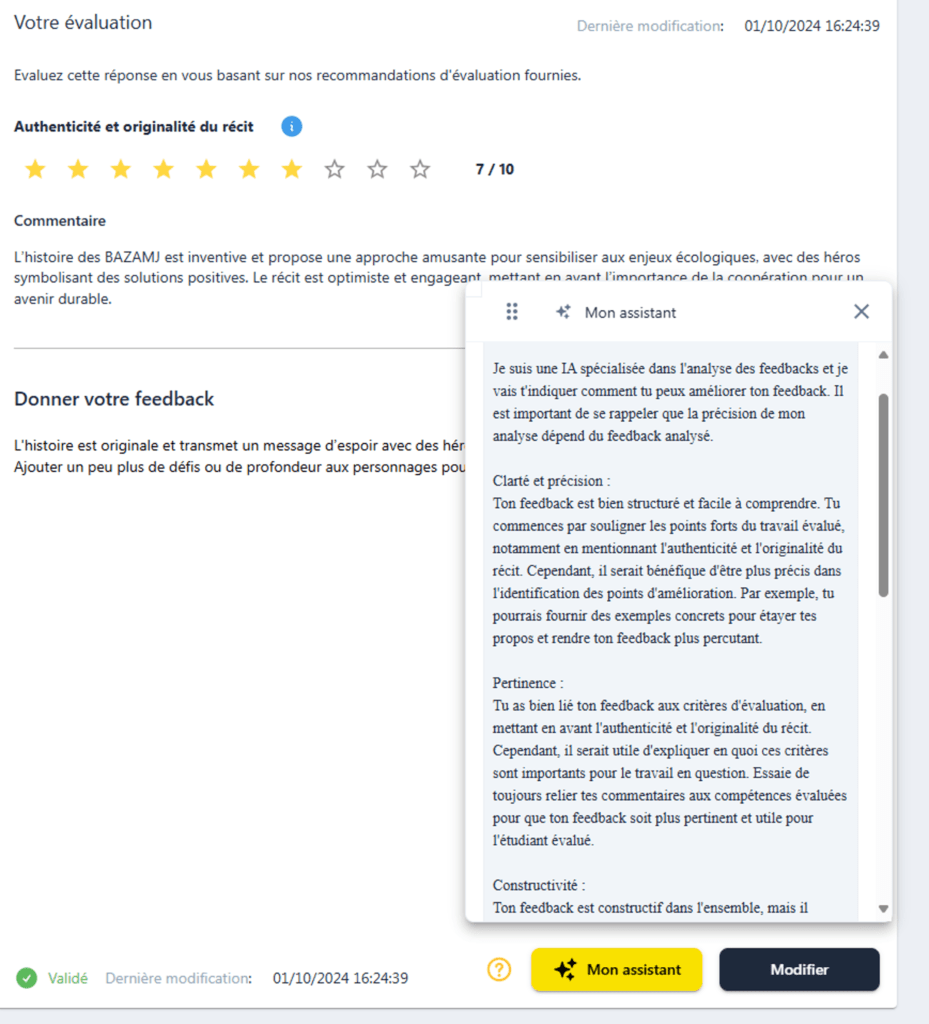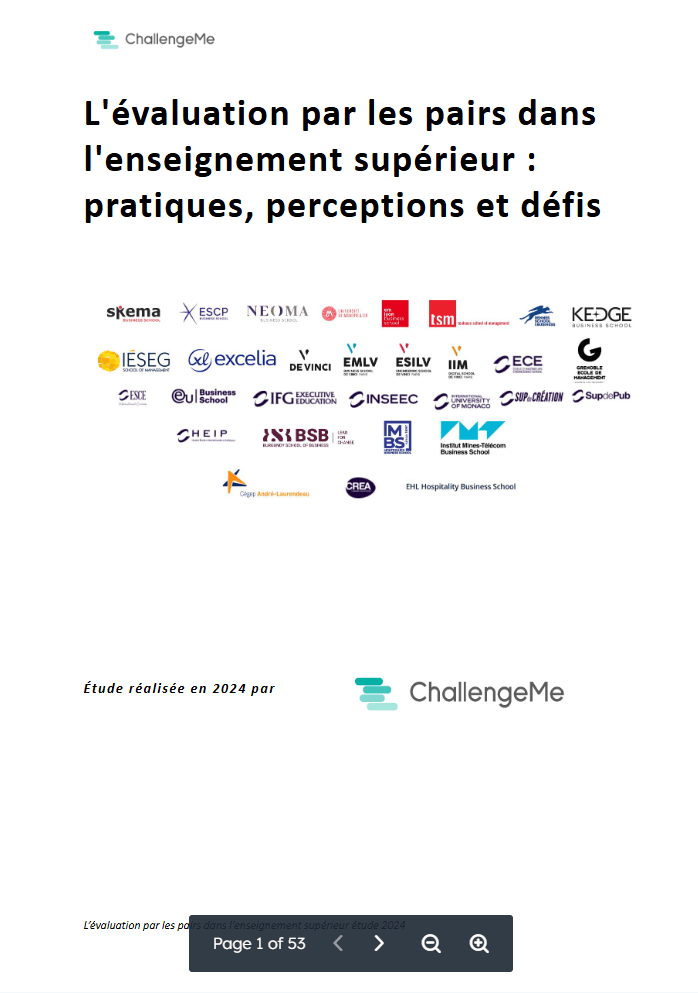In a context where higher education is constantly evolving, educational quality has become a strategic imperative. Course evaluation plays a central role in guaranteeing this quality. Not only does it enable us to gather valuable feedback from students, but also to meet the growing expectations of accreditation bodies, students and other stakeholders.
Academic accreditations such as AACSB, AMBA and EQUIS emphasize the importance of quality assurance mechanisms. When carried out properly, teaching evaluation provides the data needed to meet the criteria of these bodies, thus reinforcing the credibility and competitiveness of institutions on the international scene.
The challenges of teaching evaluation
Improving teaching practices
Teaching evaluation is a key tool for adjusting teaching methods and integrating innovations, based on concrete feedback.
Boosting student satisfaction
By giving students the opportunity to express themselves, institutions foster their commitment and sense of belonging, while optimizing their learning experience.
Meet institutional and accreditation requirements
Well-structured assessment processes are often required as part of accreditation audits. They also demonstrate a commitment to continuous improvement, which is essential if we are to remain competitive.
Anticipating future needs
By analyzing evaluation feedback, schools can better understand student expectations and adjust their programs accordingly, ensuring their relevance and impact.

Teaching assessment methods
Anonymous questionnaires
Anonymous surveys are a standard part of educational evaluation. They offer both quantitative and qualitative insights, but their effectiveness depends on good design and a high participation rate.
Student focus groups
Focus groups provide more detailed feedback on specific points. Although rich in information, they require more human resources to implement.
Continuous assessments
This method involves involving students throughout the year with regular feedback. This real-time feedback makes it possible to adapt teaching even before the end of the semester.
ChallengeMefor example, facilitates ongoing evaluations thanks to its intuitive interface and automated analysis functions. The platform helps to gather frequent feedback and integrate it effectively into teaching practices.
Digital tools
Digital tools are considerably modernizing teaching evaluation, by automating processes, centralizing data and offering in-depth analysis via dashboards.
Challenges and best practices for successful teaching evaluation
The main challenges
- Student engagement Getting relevant responses can be difficult if students don't understand the impact of their feedback.
- Administrative workload : Collecting, analyzing and processing data represents a significant workload for the teaching and administrative teams.
- Neutrality and interpretation Bias in responses or interpretation of data can distort results, making action less relevant.
Best practices
1. Communicate objectives
Students need to understand why their feedback is important. Explain clearly how their evaluations contribute to improving their own educational experience and that of future generations.
2. Simplify assessment tools
Use ergonomic and intuitive platforms, such as ChallengeMeensures easier adoption. Digital tools can also automate data collection and analysis, lightening the load on administrative teams.
3. Analyze quickly and act
Student feedback is only valuable if it's put to use quickly. Define a process for analyzing results and implementing visible actions within a reasonable timeframe. Communicating about the changes made shows that their feedback is being taken into account.
4. Involving teachers
Teachers play a key role in educational evaluation. Including them in the design of surveys and giving them access to the results motivates them to use this data to adjust their methods.
5. Encourage continuous feedback
Rather than relying on end-of-semester evaluations, integrate regular feedback into your process. Short, frequent surveys allow you to adjust teaching practices in real time and improve the student experience over time.
6. Integrate assessment into an overall quality approach
Beyond individual feedback, evaluation must be integrated into an overall system of continuous improvement. Using the data collected to guide strategic decisions guarantees a lasting impact.

Digital tools for assessment
Digital platforms are transforming the teaching assessment landscape. They offer centralized solutions for collecting, analyzing and making optimal use of student feedback.
Automated feedback synthesis for targeted action
One of the innovative features offered by ChallengeMe is its ability to generate a synthesis of student feedback using artificial intelligence. Instead of simply providing teachers with a raw list of comments, the platform analyzes the feedback and identifies key themes.
- Identifying areas for improvement By grouping similar remarks together and highlighting trends, the summary helps teachers to quickly target aspects of their teaching that require particular attention.
- Considerable time savings Teachers can concentrate on the essentials, avoiding the need to sift through hundreds of answers in order to draw useful conclusions.
Helping students structure their feedback
ChallengeMe's artificial intelligence tool doesn't just analyze feedback: it also helps students structure their feedback.
- Help for constructive feedback With real-time suggestions, AI guides students to provide clear, constructive feedback focused on specific pedagogical aspects.
- Improved quality of exchanges By receiving better-structured feedback, teachers are able to better understand students' needs and expectations, thus fostering an enriching educational dialogue.
Modernized, interactive assessment
These functions transform teaching evaluation into a collaborative, proactive process. Teachers benefit from concrete tools to improve their practices, while students are encouraged to engage in a constructive feedback process.
Tools like ChallengeMe don't just automate assessments: they add real value by facilitating interactions and making the process more relevant to all parties involved.
Conclusion: Making assessment a strategic lever
Teaching evaluation is much more than an administrative requirement: it is a powerful lever for transforming higher education. When carried out properly, it helps to improve pedagogical quality, engage students and meet the demands of an ever-changing educational environment.
By combining proven best practices with high-performance digital tools such as ChallengeMecan not only optimize their assessment processes, but also strengthen their strategic positioning and attractiveness.






